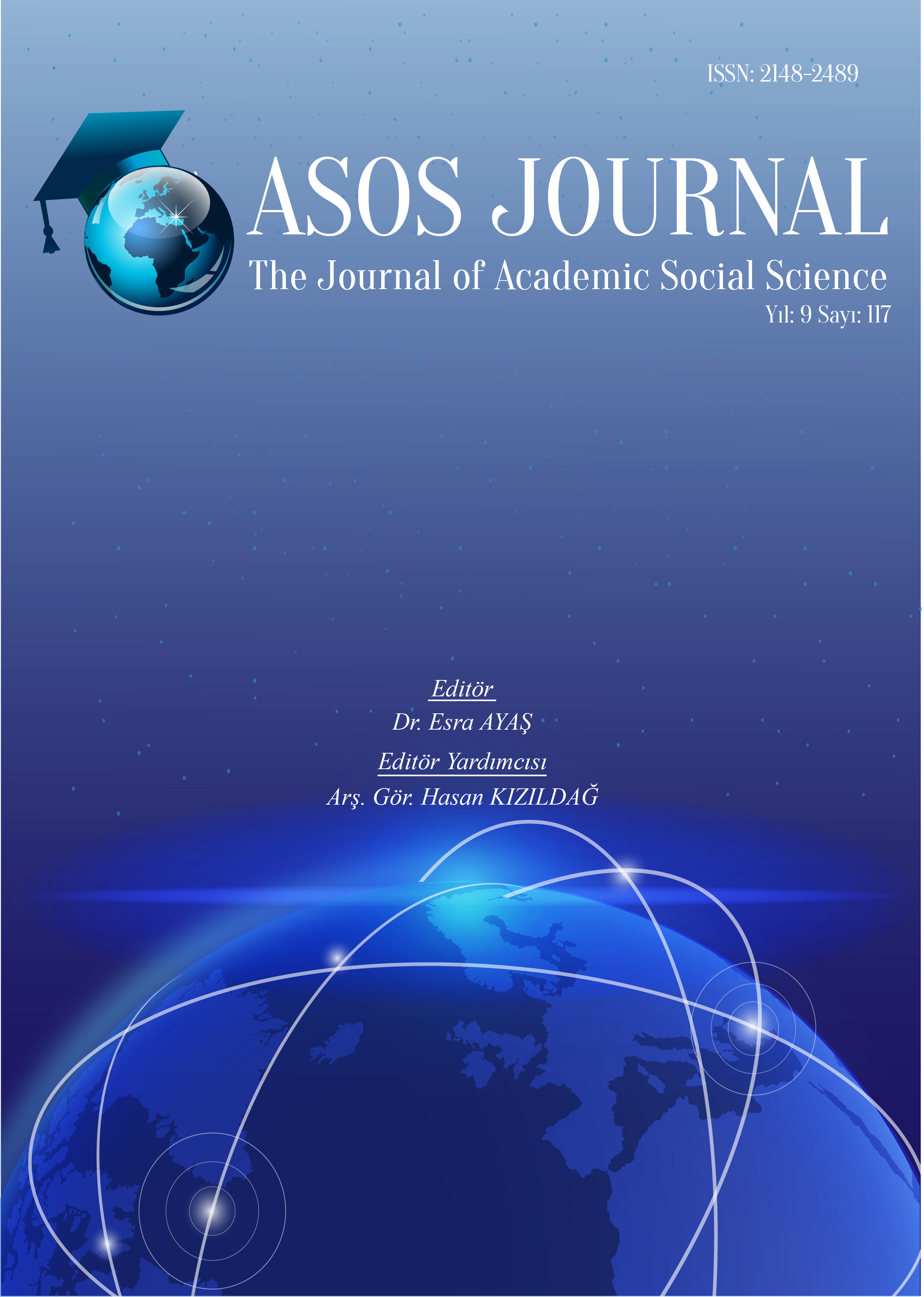Author :
Abstract
Postmodernizm diye tabir edilen günümüz modern sonrası/ötesi felsefi tartışmalarının sanattaki örneklerinde eklektizm ana dayanak noktalarındandır. Yapıtın biçim ve içerik ilişkisindeki akışı ve tutarlı mantık bütünlüğünü kıran eklektik tavır, çağımızın çoğul, eşgüdümsüz ve travmatik algıya dayalı sosyolojisinin yansıması olarak ele alınabilir. Resimsel ifadeyi kavramsal açıdan masaya yatırdığı plastik denemelerde Gerhard Richter, anlam ve duygunun kaotik kesişimlerini bu bağlamda resimsel düzlemde sorgulamayı başarmış bir öncüdür. Eserlerindeki teknik ve üslup zenginliğinin sınırsızlığına rağmen eklektik tavır içerisinde tutarlı bir bağlam bütünlüğünden söz edilebilir. Bu sebeple tek bir ressamın birçok üslubu olması vurgusu her ne kadar ironik gibi görünse de birbirinden çok farklı ve uzak eğilimleri eşgüdümlü uygulayan Richter için uygun bir eğretilemedir. Sanatçının önemi, bu üslup ve teknik zenginliğinin ötesindeki ilişkisel mesafede bağlam sorgulamasından kaynaklanmaktadır. Zira sanatçı en öznel ailevi konularındaki içeriklerinde dahi algısal mesafeyi ve resimsel ifadedeki toplumsal algı aralığını öne almaktadır. Sanatçının resimlerindeki eklektik kurgularda postmodern bakış açısı ile modern bilincin çağımıza ışık tutan öznel/nesnel, tanım/konum gerilimleri öne çıkmaktadır. Bu çalışmanın amacı çoğul ve merkezsiz postmodern bakış açısının bireysel travmatik yansımalarının Richter’in içeriğine dönüşen biçim deneyimleridir. Richter’in sanatını üretim süreci içerisinde ele alan bu çalışma eserlerinin görsellerine eşlik edecek şekilde düzenlenmiştir. Sanatçının biçim ve içerik ilişkilerindeki eklektik tavır, ilgili örnek eserleri üzerinden incelenerek postmodern bir tanım sorgulaması gerçekleştirilir. Çalışma, nitel araştırma tekniği ile betimsel çözümleme üzerinden ilerlemektedir.
Keywords
Abstract
Eclecticism is one of the main mainstays of today's post/beyond modern philosophical discourse debates that is known as postmodernism in the field of art. The eclectic attitude that breaks the flow and the coherent logic integrity of the work in the relationship of form and content is considered as the reflection of the sociology of our age based on plural, uncoordinated and traumatic perception. Gerhard Richter is a pioneer who has succeeded in questioning the chaotic intersections of meaning and emotion on the pictorial plane in this context in his plastic essays, where he discusses pictorial expression conceptually. Despite the unlimited technical and stylistic richness of his works, a consistent unity of context can be mentioned. For this reason, although the emphasis on being a single painter with many styles seems ironic, it is an appropriate metaphor for Richter, who coordinates very different and distant tendencies. The importance of the artist stems from the questioning of context in the relational distance beyond this stylistic and technical richness. Because the artist deals with the perceptual distance and the range of social perception in pictorial expression even in his most subjective familial content. In the eclectic fictions of the artist's paintings, subjective / objective, definition / location tensions that shed light on the modern consciousness with a postmodern perspective come to the fore. The aim of this study is to recognise the transform of the individual traumatic reflections of the plural and decentralized postmodern perspective that turn into Richter's content. This work, which deals with Richter's art in the production process, has been arranged to accompany the visuals of his works. The eclectic attitude of the artist in the relations of form and content is examined through the relevant sample works and a postmodern definition question is made. The study proceeds through qualitative research technique and descriptive analysis.
Keywords
- Antmen, Ahu, (2008), 20. Yüzyıl Batı Sanatında Akımlar, Sel Yayıncılık. İstanbul. Bourriaud, Nicolas, (2005), İlişkisel Estetik (Çev., Saadet Özen), Bağlam Yayıncılık, İstanbul. Cebrailoğlu, Orhan, (2013), “Modernizm-Postmodernizm Kıskacında Sıradışı Bir Sanatçı; Gerhard Richter”, Gazi Üniversitesi Endüstriyel Sanatlar Eğitim Fakültesi Dergisi, Sayı: 32, s.115-126. Hopkins, David, (2000), After Modern Art 1945-2000. Series: Oxford history of art. Oxford University Press: Oxford. ISBN 019284234X Lyotard, Jean-François, (2013), Postmodern Durum, (Çev., İsmet Birkan), Bilgesu Yayınları, Ankara.
- Rona, Zeynep, Eczacıbaşı Sanat Ansiklopedisi, İstanbul: Yem Yayınevi. 2008. Richter, Gerhard, (2011), “Benjamin Buchloch ile Söyleşi”den, Charles Harrison, Paul Wood (Ed.), Sanat ve Kuram 1900-2000 Değişen Fikirler Antolojisi (çev., Sabri Gürses). İstanbul. Küre Yayınları, s.1201-1212. 1212
- Şengül, Erhun, (2013), Sanat ve Tasarım Dergisi, Çağdaş Sanat Yapıtlarının Plastik ve Mekanik Süreç Etkileşiminde Fotoğrafın Yeri, Cilt 5, Sayı 5, 70 – 83.
- İNTERNET KAYNAKLARI Eklektizm nedir?, https://www.milliyet. com.tr/eklektizm-nedir--molatik-11477/, Erişim Tarihi: 25.02.2021 Eklektizm Nedir, Ne Demektir? Yayın Tarihi: 25.02.2021 https://www.felsefe.gen.tr/eklektisizm-eklektizm-nedir-ne-demektir/ Erişim Tarihi: 10.03 2021. Güven, Mahir, (2019), Bir Resim Bir Hikâye, Betty, 1. Bölüm, Konuk: Erişim Tarihi: 15.12.2020. Gülveli Kaya, https://www.youtube.com/watch?v=AsGgyQe-s3g, Erişim Tarihi: 17.01 2021. Heiner Friedrich, http://www.diaart.org/, Erişim Tarihi: 10.11 2015. Milliyet Sanat, ''Domplatz'' 37 milyon dolara satıldı. http://www.milliyetsanat.com/haberler/ plastik-sanatlar/--domplatz---37-milyon-dolara satildi/1981, yayın tarihi: 15 Mayıs 2013 - 04:05, Erişim Tarihi: 20.05.2018.
- Richter, Gerhard, http://www.gerhard-richter.com/chronology/ Erişim Tarihi: 10.03.2017. Vargı, Yasemin. “Gerhard Richter Beyeler Foundation'da - Yazan Yasemin Vargı”, ekavart tv, https://www.arttv.com.tr/yazi/gerhardrichter-beyeler foundationda yazan-yasemin-varg, Erişim Tarihi: 20. 10. 2019, GÖRSEL KAYNAKÇA
- Resim 2: Gerhard Richter, Bulutlu Deniz Manzarası, 200x200 cm, Tuval üz. Yağlıboya 1969. https://www.gerhard-richter.com/en/art/paintings/photo-paintings/seascapes-22/seascape
- Resim 3: Gerhard Richter, Vurulmuş Adam 1, Tuval üz. Yağlıboya, 100.5 x 140.5 cm. 1988. https://www.gerhard-richter.com/it/art/paintings/photo-paintings/baader-meinhof56/man-shot-down-1-7691
- Resim 8: Gerhard Richter, Titian’ın “Müjde”sine ithafen, 125 x 200 cm, Tuval üz. Yağlıboya, 1973, https://www.gerhard-richter.com/en/art/paintings/photo-paintings/old-master
- Resim 10 (Sağda): Gerhard Richter, Merdivenden İnen Kadın, 198 cm x 128 cm, Tuval üz. Yağlıboya, 1965. https://www.artic.edu/artworks/147003/woman-descending-thestaircase-frau-die-treppe-herabgehend
- Resim 12: Gerhard Richter, Anne ile Bebeği, Tuval üz. Yağlıboya, 1970. https://www.arts- ny.com/art-nyc-gerhard-richter-painting-after-all-metmuseum/ https://www.gerhard-richter.com/de/art/paintings/abstracts/abstracts-2005-onwards69/forest-10476/?p=1&sp=32
- Resim 16: Gerhard Richter, 4, 16, 256, 1024, Tuval üz. Yağlıboya, Galerie Zwirner, Cologne, 1974. http://www.theartwolf.com/exhibitions/richter-serpentine.htm
- Resim 17: Gerhard Richter, Şeritler, 160 cm x 300 cm Katalog Raisonné: 920-3, Alüminyum ve Perspex (Diasec) arasında kâğıt üzerine dijital baskı, 2011. https://www.gerhardrichter.com/en/art/paintings/abstracts/strips-93/strip15368/?&categoryid=93&p=1&sp=32





